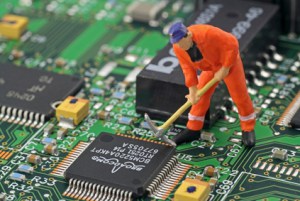As written in my last week’s blog post, by deploying ’wartungsfrei’ (maintenance-free) industrial computer platforms, OEMs and operators can both: reduce operating costs and increase the reliability of system installations. Eliminating the need for maintenance and the costs associated with it also minimizes production downtime preventing unnecessary profit loss.
’Wartungsfrei’: Let’s Reduce the “Total Cost of Ownership”
By deploying ’wartungsfrei’ (maintenance-free) industrial computer platforms on-site, OEMs and operators can both reduce operating costs and increase the reliability of system installations. In turn, maintenance costs can be reduced while minimizing production downtime to prevent unnecessary profit loss. In fact, profit losses caused by production downtime for maintenance are a costly issue even if industrial computer platforms only represent a small portion of the maintenance work required in the overall application. Maintenance costs will quickly add up and include expenses for staff travel and replacement parts (both available inventory and newly sourced) that tie up warehouse capacity and capital. Even necessary maintenance planning presents a sizeable cost factor in terms of budget, staff resources and facilities management. Maintenance-free systems allow OEMs to put all these factors aside. No additional special maintenance strategies have to be executed in order to achieve high availability. Once installed, these systems continue to run reliably day in, day out for 24/7 operation – throughout the designated application lifecycle.

@Schliemer/fotolia.com
Maintenance-Free Systems: High Demands for each Component
Based on the required feature set or performance, Kontron – for example – has defined different levels of ’wartungsfrei’. But to maximize the level of ‘wartungsfrei’ in all products, industrial computer platforms should meet these five important requirements:
1. No moving parts
A primary requirement of ‘wartungsfrei’ systems is that they cannot have anymoving parts, such as fans or hard disk drive storage. Components such as these have a tendency to wear out more easily mandating replacements for long-term installations. They are also vulnerable to shock and vibration, which in harsh industrial environments can increase the risk of failure. Fanless industrial computer platforms with flash-based memory offer the ideal solution, as flash memory does not have moving parts and eliminates mechanical failure.
2. Energy-efficient components
The second precondition is the use of energy-efficient components. The latest processors offer, for example, excellent performance-per-watt ratios generating minimal heat, which makes active fan cooling superfluous. This also reduces mechanical wear. Today’s, leading market solutions offer low power CPUs and energy-efficient SoCs such as Intel® Atom™ processors. High-performance systems delivered in a compact format are also possible with today’s advanced processor architectures. Even with high-end 4th generation Intel® Core™ processors, power consumption can be lowered enough to enable a fanless design.
3. Battery-free operation
Classic button cell batteries, which have to be replaced every two to three years, are not suitable for ’wartungsfrei’ systems. Wear-free double layer capacitors – so-called gold caps – which do not require replacements are an excellent alternative. These capacitors ensure the continuous power supply to the BIOS or the EFI memory and the internal clock system even when the system is switched off and disconnected. Without a continuous power supply, system settings and the system clock would need to be reset andthe system would not be able to reboot without user intervention.
4. Extended power supply functions
Power supplies with high holdup times, can prevent a system reset in the case of a quick power failure. During this downtime, the system runs normally, which increases the application’s availability. Power supplies need to be programmed to automatically reboot a system after a power failure (longer than the specified holdup time). In this way, operation can continue without any user intervention.
5. Long-life components
Ultimately, a system can only be as good as its weakest component. Careful selection of the right components is crucial. Long-life components that offer a high MTBF are essential, and it does not suffice to just have suitable processors and chipsets that just meet harsh environment requirements. Logically, all the parts on the selected board such as voltage regulators, controllers, and memory modules must be specified to withstand extreme ambient temperatures and temperature fluctuations over time without any adverse effects.
The requirements outlined above highlight at the hardware level there are high demand for each component in the overall system to live up to the ‘wartungsfrei’ concept. Many of the “wartungsfrei”-specific design features are not simply found in data sheets, making it difficult for developers to identify what products provide maintenance-free benefits. To ensure all aspects of high-reliability designs, OEMs need to make very detailed enquires about a system’s specifications.Nevertheless, there is much more to ‘maintenance free’ design than simply using the right hardware.
Operators need to be able to rely on the functionality of the system. Therefore, all the relevant parameters, the ‘big data’ these industrial computer platforms must manage, have to be available remotely and around the clock. OEMs and operators profit in many ways from remote monitoring and management. If you want to know more about it, stay tuned for next week’s blog post and get more information in our new ‘wartungsfrei’-whitepaper.


{{comment.comment}}